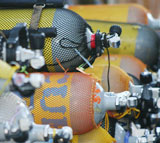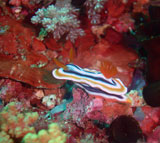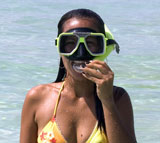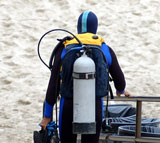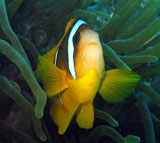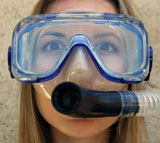Fins
by Conrad H. Blickenstorfer
Almost everyone has at some point used fins, a snorkel and a mask. This trio is what most people think of when they consider snorkeling and diving, or just want to splash around in the pool or perhaps a small lagoon. Problem is that, just as with snorkels and masks, many never graduate past using a cheap pair of fins that barely works and quickly breaks. 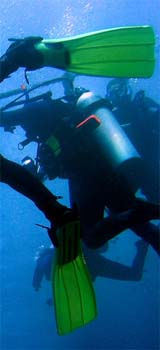 That's too bad as fins are an important, essential part of the diving and snorkeling experience. Our feet simply aren't made for propelling the human body through the water. Fins help us do that quickly and effortlessly. With the proper pair of fins, the legs do all the work and hands are only used to make small adjustments. That's too bad as fins are an important, essential part of the diving and snorkeling experience. Our feet simply aren't made for propelling the human body through the water. Fins help us do that quickly and effortlessly. With the proper pair of fins, the legs do all the work and hands are only used to make small adjustments.
While fins are important for casual snorkelers and add a lot to the enjoyment of the sport, they are totally essential for scuba diving. With the extra drag of the scuba equipment and the necessity to precisely control movement, having the right set of fins is mandatory. So knowing what is out there, what options are available, and what works best under what conditions is important.
While those unfamiliar with fins may think that with the exception of some variation in quality and price, fins are all pretty much the same, nothing could be farther from the truth. The leading scuba equipment manufacturers are all spending a lot of time and money researching new and more efficient designs, space-age materials, new manufacturing techniques, and entirely new concepts in order to provide the proper fin for every class of diver and every type of diving environment.
So let's take a look at the various types and kinds of fins on the market today.
Full-foot or adjustable
There are basically two types of fins used in diving and snorkeling, full-foot designs and adjustables. Each has its special purpose and works best for certain applications.
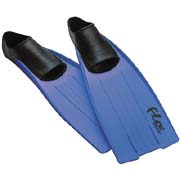 Full-foot fins are essentially shoes with fins attached. They have a heel part and you simply step into them. They are generally the most flexible and comfortable, but you have to make sure they fit just right as there aren't any adjustments. Full-foot fins are primarily used for snorkeling. They are easy to put on and off, and there is no need to wear booties. One drawback is that the heel part can tear and that's the end of the fin. Shown on the right is the Oceanic Flex, a basic, inexpensive full-foot design that is exceptionally lightweight but delivers consistent performance and response in the water. A fin like that is ideal for snorkeling for all levels of expertise. Full-foot fins are essentially shoes with fins attached. They have a heel part and you simply step into them. They are generally the most flexible and comfortable, but you have to make sure they fit just right as there aren't any adjustments. Full-foot fins are primarily used for snorkeling. They are easy to put on and off, and there is no need to wear booties. One drawback is that the heel part can tear and that's the end of the fin. Shown on the right is the Oceanic Flex, a basic, inexpensive full-foot design that is exceptionally lightweight but delivers consistent performance and response in the water. A fin like that is ideal for snorkeling for all levels of expertise.
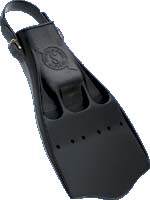 Adjustable fins are what people generally wear for scuba diving. They don't have a rubber heel built in. Instead, there is an adjustable strap around the heel that keeps the foot in place. Adjustables are generally worn with diving booties which are pretty much mandatory when diving in even moderately cool water. This means that when you buy a set of adjustable fins, you need to try them on while wearing the boots. A big advantage of adjustables is that the straps can be replaced. If a strap breaks, you don't lose the (often considerable) investment in a pair of fins. Adjustable fins are generally more heavy-duty than full-foot fins, and they provide more thrust. In order to do that, their blades are stiffer and usually larger. The fin on the right is the Scubapro Jet Fin, a tried-and-true classic design that's been around for over 40 years! Adjustable fins are what people generally wear for scuba diving. They don't have a rubber heel built in. Instead, there is an adjustable strap around the heel that keeps the foot in place. Adjustables are generally worn with diving booties which are pretty much mandatory when diving in even moderately cool water. This means that when you buy a set of adjustable fins, you need to try them on while wearing the boots. A big advantage of adjustables is that the straps can be replaced. If a strap breaks, you don't lose the (often considerable) investment in a pair of fins. Adjustable fins are generally more heavy-duty than full-foot fins, and they provide more thrust. In order to do that, their blades are stiffer and usually larger. The fin on the right is the Scubapro Jet Fin, a tried-and-true classic design that's been around for over 40 years!
Blade design
While all fins are designed to provide forward thrust underwater, there are numerous different blade designs. The blades may have side rails to provide extra stiffness. They may combine soft and firm areas in an effort to provide maximum thrust. The blades may have vents said to reduce drag. Some seem designed on a computer and use geometric shapes whereas others seem inspired by nature. Some have ribs that can make a blade firmer and keep it from wobbling. And there are split fins that create a propeller-like effect said to increase speed at reduced effort. No two pairs of fins are alike.
Materials
While all fins look like they are simply made of good old-fashioned rubber, that is only partly true. Today's advanced fins use space age polymer materials that can be lighter, more resistant to wear, and both stuffer or more flexible. Interestingly, the choice of material often affects the buoyancy of the fins. Scubapro's adjustable Twin Jet fins come in four colors, with the black materials being a bit stiffer and having a slightly negative buoyancy whereas the three color versions are a bit lighter and more flexible, and have a slightly positive buoyancy.
Colors
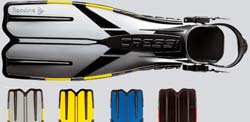 Just like masks and snorkels, fins come in many colors, and combinations of colors, and divers often use them as fashion statements. Pick whatever you like, but keep in mind that different color fins of the same design may have different properties. The fin to the right is Cressi-sub`s Rondine A, a concept that Cressi says delivers exceptional performance for all divers in all diving conditions thanks to a balanced variable flex blade.
Just like masks and snorkels, fins come in many colors, and combinations of colors, and divers often use them as fashion statements. Pick whatever you like, but keep in mind that different color fins of the same design may have different properties. The fin to the right is Cressi-sub`s Rondine A, a concept that Cressi says delivers exceptional performance for all divers in all diving conditions thanks to a balanced variable flex blade.
What to get???
When shopping for fins, be prepared to find it harder to make a decision the more you learn about the different designs. Every manufacturer has their own patented methods and design, their own secret materials and compounds, and, of course, numerous sexy and eye-catching designs. Learn as much as you can, become familiar with the terminology, ask experienced divers, and try to figure out the often confusing sizing system.
Fins come in many sizes and weights. If you travel a lot and like to travel light, that can make a difference. A smaller size fin is a whole lot easier to transport.
When selecting fins, pick up each pair and compare weight. You'll be amazed at the large differences. Rigid, sturdy fins may work well on some people with strong leg muscles and lots of diving practice, but a much lighter, more flexible design may be better for beginners. Experts swear that a fin that is too rigid and heavy is almost guaranteed to cause a lot of cramping.
But never forget the most important part: the fins must fit well and be comfortable. Unlike sneakers or leather shoes, you can't really "break in" fins. They either fit or they don't. If you buy the wrong fins, or a set that doesn't fit right, you quickly cramp up or get blisters. So make certain you buy a set that works for you and is made for the type of diving you have in mind. If you do, you'll be rewarded with a wonderful extension of your body, one that lets you glide through the water elegantly and with ease. And isn't that what diving is all about?
Examples of different fins
Below are examples of some of the different fin designs available today.
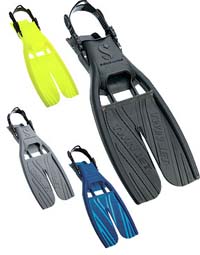 The Scubapro Twin Jet on the left is an adjustable fin with a patented split-fin propeller technology that delivers more forward motion with less effort than standard blades. It has drag-reducing vents that cut down on the resistance to up and down strokes, and has an extended sole plate to leverage the power stroke. Quick connect swivel buckles make it easy to put the fins on and take them off. They come in four different colors with, as explained above, the black version being somewhat stiffer and less buoyant than the three other colors (graphite, cobalt, and hi-viz yellow).
The Scubapro Twin Jet on the left is an adjustable fin with a patented split-fin propeller technology that delivers more forward motion with less effort than standard blades. It has drag-reducing vents that cut down on the resistance to up and down strokes, and has an extended sole plate to leverage the power stroke. Quick connect swivel buckles make it easy to put the fins on and take them off. They come in four different colors with, as explained above, the black version being somewhat stiffer and less buoyant than the three other colors (graphite, cobalt, and hi-viz yellow). 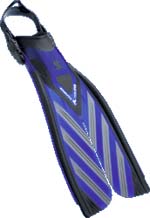 The Scubapro Twin Jet is an example of an advanced, high end fin with a price to match.
The Scubapro Twin Jet is an example of an advanced, high end fin with a price to match.
Compared to the high-tech looking Twin Jet, Scubapro's Twin Speed (shown on the right) features a much more organic form. The company says its long, flowing shaped was indeed derived from closely observing nature. This very elegant fin combines style and performance (30% more efficient than traditional fins) and uses a patented tri-compound construction that is rigid in places and soft and flexible in others.
The splashy and colorful Cressi Pluma, shown below, is a typical snorkeling fin, and one full of Italian flair. It is a classy design that encases the swimmer's foot completely inside the foot pocket, offering exceptional comfort and enhanced performance. Cressi uses three different thermoplastic materials in the high tech design of the Pluma.
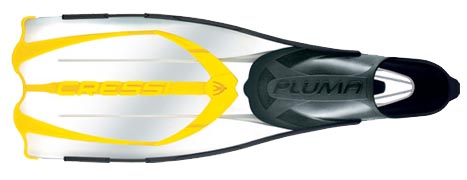
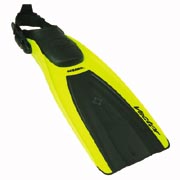 The Oceanic Vector was designed for divers who want a smooth fluid feel in a conventional paddle fin design with an extra kick. Water flow is directed off the back of the blade, reducing stress on the diver's leg while accelerating the water over the blade, resulting in increased speed. This reasonably priced adjustable design fin can be used for all diving and snorkeling skill levels. It has oversized blades for good thrust, a flexible center channel that accelerates water over the blade for improved efficiency, and easy to adjust quick-release buckles. The Oceanic Vector was designed for divers who want a smooth fluid feel in a conventional paddle fin design with an extra kick. Water flow is directed off the back of the blade, reducing stress on the diver's leg while accelerating the water over the blade, resulting in increased speed. This reasonably priced adjustable design fin can be used for all diving and snorkeling skill levels. It has oversized blades for good thrust, a flexible center channel that accelerates water over the blade for improved efficiency, and easy to adjust quick-release buckles.
|


